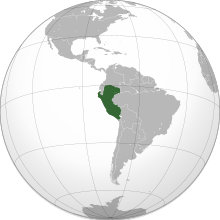This article includes a list of general references, but it lacks sufficient corresponding inline citations. (May 2024) |
Peruvian Republic República Peruana | |||||||||
|---|---|---|---|---|---|---|---|---|---|
| 1895–1919 | |||||||||
| Motto: "Firme y feliz por la unión" (Spanish) "Firm and Happy for the Union" | |||||||||
| Anthem: "Himno Nacional del Perú" (Spanish) "National Anthem of Peru" | |||||||||
| Capital | Lima | ||||||||
| Common languages | Spanish | ||||||||
| Religion | Roman Catholicism | ||||||||
| Demonym(s) | Peruvian | ||||||||
| Government | Unitary presidential republic | ||||||||
| President | |||||||||
• 1895–1899 (first) | Nicolás de Piérola | ||||||||
• 1915–1919 (last) | José Pardo y Barreda | ||||||||
| Legislature | National Congress | ||||||||
| Historical era | Belle Époque | ||||||||
| 8 September 1895 | |||||||||
| 1896 | |||||||||
| 1896–1897 | |||||||||
| 1899 | |||||||||
| August 1903 | |||||||||
| 9–12 August 1904 | |||||||||
| May 1908 | |||||||||
| 29 May 1909 | |||||||||
| 1910 | |||||||||
| 25–26 August 1912 | |||||||||
• 1915 elections | 16–17 May 1915 | ||||||||
| 4 July 1919 | |||||||||
| 18–19 May 1919 | |||||||||
| Currency | Libra de oro Sol (until 1898) | ||||||||
| |||||||||
| History of Peru |
|---|
 |
|
|
The name of Aristocratic Republic (Spanish: República Aristocrática) is given to the period following the election of Nicolás de Piérola as President of Peru. This period was characterised by the political dominance of an oligarchy dedicated to agro-exports, mining and finance, through the Civilista Party. The term was coined by historian Jorge Basadre. During this period, the so-called Second Civilism (Spanish: Segundo civilismo) took place, in contrast to that of 1872 to 1876.
The period begins with the rise to power of Nicolás de Piérola, which marks the beginning of a succession of democratically elected governments, until the coup of Augusto B. Leguía in 1919. The only interruption of this succession occurred in 1914 when, due to differences between the Civilista Party and Guillermo Billinghurst, General Óscar R. Benavides carries out a coup d'état to call general elections. It is the second longest period of democratic succession in the republican history of Peru.[1]
- ^ Barrenechea, Melissa (2019-04-21). "Perú bate su récord histórico de democracia ininterrumpida". RPP Noticias.
© MMXXIII Rich X Search. We shall prevail. All rights reserved. Rich X Search




